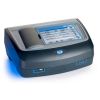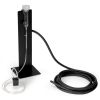Hach DR1900 Portable Spectrophotometer
The Hach DR1900 portable spectrophotometer is perfect for use in the field because of the lightweight and compact design.
Features
- Carry anywhere due to a thoughtful, compact design
- Ensure accuracy in the field
- Clear, easy-to-use interface
- Free ground shipping
- Expedited repair and warranty service
- Lifetime technical support
- More
Overview
The Hach DR1900 portable spectrophotometer excels in the field because of the lightweight and compact design. The DR1900 is built for rugged conditions, and it’s flexible, --accepting the widest range of vial sizes.
Built with field use in mind, the DR1900 has a large, clear screen and a simple user interface that makes testing easier than ever in even the most demanding conditions.
Advanced Testing
Easy to hold, and operate, the compact DR1900 is a valuable tool for your field technicians. Underneath the rugged exterior, the DR1900 has the largest number,-- over 220-- of the most commonly tested preprogrammed methods already built in. You can also use the easy-to-use interface to create your own methods.
Tests are performed with a wavelength range of 340 to 800 nm which make this a field instrument you can use to find results typically only seen in laboratory instruments.
Notes
Reagents listed below are EPA approved. For the full list of reagents and methods that can be used with the DR1900, refer to the Hach Methods Quick Reference Guide
TNTplus vial test evaluation possible, but without barcode identification & 10 fold measurement and outlier elimination.
- Battery Life: 15 days (typical) @ 5 readings a day / 5 day week without backlight*
- Battery Requirements: 4, AA size alkali cells
- Cuvette Compatibility 2: 10 mm square / 1 inch square and 13 mm / 16 mm / 1 inch round
- Data Logger: 500 measured values (Result, Date, Time, Sample ID, User ID acc. to GLP)
- Detector: Silicon photodiode
- Dimensions (H x W x D): 98 mm x 178 mm x 267 mm
- Display: Graphical display 240 x 160 pixel (LCD, b/w, backlit)
- Enclosure Rating: IP67
- Interface: USB type Mini IP67 (with USB + Power Module)
- Mains Connection 2: 110 - 240 V / 50/60 Hz (* optional Module required. May not be available in all regions)
- Mains Connection 3: 4x NiMH rechargeable Battery (* optional Module required. May not be avaliable in all region)
- Operating Conditions: 10 - 40 °C (50 - 104 °F), max. 80 % relative humidity (non-condensing)
- Operating Humidity: Max. 80 % relative humidity (non-condensing)
- Operating Mode: Transmittance (%), Absorbance and Concentration
- Operating Temperature: 10 - 40 °C
- Optical System: Reference beam, spectral
- Photometric Accuracy: ± 0.003 Abs @ 0.0 - 0.5 Abs
- Photometric Linearity: < 0.5 % (0.5 - 2.0 Abs)
- Photometric Measuring Range: 0 - 3 Abs (wavelength range 340 - 800 nm)
- Power Module?: Yes
- Power Supply: 4 x AA size Alkaline
4x NiMH rechargeable Battery
Power supply: 110 - 240 V; 50/60 Hz - Region: US
- Reproducibility: ± 0.005 Abs (0 - 1 A)
- Sample Cell Compatibility: 13 / 16 mm and 1 inch round 10 x 10 mm 1 inch square adapter for round vials and 10x10mm
- Source Lamp: Xenon Flash
- Storage Conditions: -30 - 60 °C (-30 - 140 °F), max. 80 % relative humidity (non-condensing)
- Stray Light: < 0.5 %T at 340 nm with NaNO2
- Temperature Range: 0 - 50 °C (32 - 122 °F)
- User Interface Languages: English, French, German, Italian, Spanish, Portuguese, Bulgarian, Chinese, Czech, Danish, Dutch, Finnish, Greek, Hungarian, Japanese, Korean, Polish, Romanian, Russian, Slovenian, Swedish, Turkish
- User Programs: 50
- Warranty: 12 months
- Wavelength Accuracy: ± 2 nm (range 340 - 800nm)
- Wavelength Calibration: Automatic
- Wavelength Range: 340 - 800 nm
- Wavelength Selection: Automatic
- Weight: 1.5 kg
- What's included?: portable spectrometer, printed basic instrument manual, dust cover, 1-in. square matched glass sample cells, AA alkaline batteries 4/pk, a four-type vial adapter set, and a USB + Power module (LZV813).
* Backlight usage will decrease battery life.
- Portable spectrometer
- Printed basic instrument manual
- Dust cover
- 1-in. square matched glass sample cells
- AA alkaline batteries 4/pk
- Four-type vial adapter set
- USB + Power module (LZV813.99.00002)
In The News
Three Decades of Research at Acton Lake
A multi-disciplinary team at Miami University, Ohio, has been studying the environmental change at Acton Lake for over three decades. Using three different NexSens buoys over this time, the team has an incredible archive of data that is helping build a picture of Acton’s past, present, and future. Until recently, a NexSens CB-50 buoy was used alongside other environmental monitoring at Acton Lake. In May 2025, the Miami team deployed a new XB-200 buoy , future-proofing their ongoing monitoring using real-time buoy systems. Acton Lake, a small hypereutrophic reservoir in southwest Ohio, covers 2.4km² and has a maximum depth of about 8m. The dam was built in 1956, and the lake has a large agricultural watershed.
Read MoreSource Water Monitoring in Albany, New York: Tracing Water Quality throughout Tributaries
Thousands of US cities pull their drinking water from natural source waters like reservoirs, rivers, and streams, making overall watershed health a key consideration for water providers. In Albany, New York, the Albany Department of Water and Water Supply delivers drinking water to over 100,000 residents as well as monitors and manages the larger drinking water supply watershed. Hannah Doherty, Environmental Specialist at the Albany Department of Water and Water Supply , spends her days working with a small team to monitor the drinking supply and the connected water bodies. Doherty explains, “We’re the first to encounter the water that ends up being the drinking water.
Read MoreWildfire Prevention in the Sierra Nevada Region with the Yuba Watershed Institute
Though recent wildfires have sparked new conversations about wildfire management and response, groups like the Yuba Watershed Institute have been monitoring the forests and water resources of the Sierra Nevada region for decades, managing approximately 5,000 acres of land with the Bureau of Land Management (BLM) and about 7,000 acres in private land partnerships. The goal of the Institute is to work with local communities and land agencies to improve watershed and forestry management through informed practices and public outreach. The goals of the Yuba Watershed Institute are three-fold: Improve the ability of fire suppression agencies like the California Department of Forestry and Fire Protection ( CAL FIRE ) and the US Forest Service.
Read More




























































